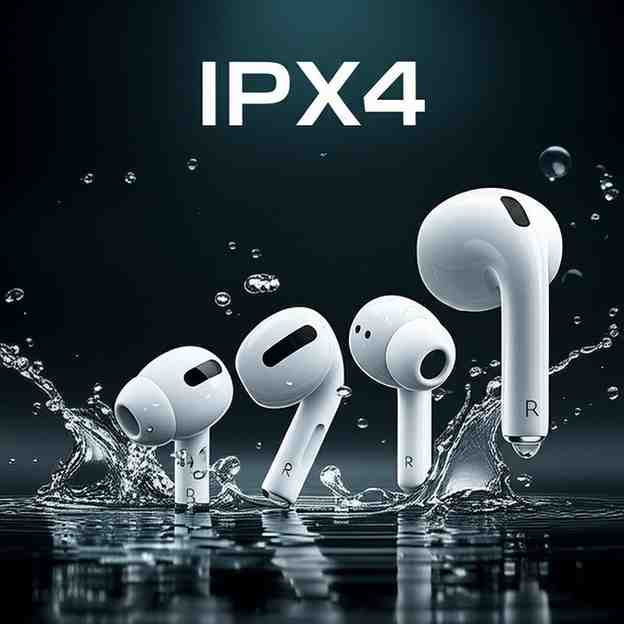Have you ever found yourself caught in a sudden downpour, heart pounding, as you realize your beloved AirPods are exposed to the elements? Or perhaps you’ve wondered if they can survive a sweaty workout or an accidental dip in the sink?
It’s a common question, and honestly, it’s a bit more nuanced than a simple yes or no. Many people assume their expensive earbuds are built to withstand anything, but when it comes to water, there are some important facts you need to know.
Let’s dive deep into the world of AirPods and their water resistance, so you can protect your tech and keep the music playing!
Key Takeaways
- Not Fully Waterproof: No AirPods model is truly waterproof; they are water-resistant to varying degrees.
- IPX Ratings Matter: Newer models like AirPods 3, AirPods Pro (all generations), and AirPods Max have an IPX4 rating, meaning they can handle splashes and sweat.
- Older Models & Cases: Older AirPods (1st and 2nd Gen) and all charging cases have no official water resistance.
- Protect Your Investment: Avoid submerging AirPods, keep them away from harsh liquids, and always dry them thoroughly if they get wet.
- Warranty Won’t Cover Water Damage: Apple’s warranty does not cover damage caused by liquid exposure, so prevention is key!
Table of Contents
Understanding Water Resistance: What’s the Difference?
Here’s the thing: people often mix up “waterproof” and “water-resistant.” And actually, it’s a super important difference, especially when we’re talking about electronics.
- Waterproof means something is completely sealed and can be submerged in water without any damage, often for specific depths and durations. Think of a submarine or a high-end diving watch.
- Water-resistant means an item can resist the penetration of water to some extent. It can handle splashes, sweat, or light rain, but it’s not designed to be submerged. Most modern gadgets, including many smartphones and smartwatches, fall into this category.
So, when someone asks, “Are AirPods waterproof?” the short answer is no, none of them are truly waterproof. They are, however, water-resistant to different levels, depending on the model. This resistance is measured by something called an IP rating.
What Do IPX Ratings Mean?
You’ll often hear about “IP ratings” when talking about electronics and water. IP stands for “Ingress Protection,” and it’s a standard used to show how well an electronic device is protected against solids (like dust) and liquids (like water).
An IP rating usually has two numbers after “IP.” For example, IP67.
- The first number tells you about protection against solids (dust, dirt, etc.). This ranges from 0 (no protection) to 6 (dust-tight).
- The second number tells you about protection against liquids (water). This ranges from 0 (no protection) to 8 (can be submerged for long periods under pressure).
Sometimes, you’ll see “IPX4” or “IPX7.” The “X” just means that the device hasn’t been tested or rated for protection against solids. So, IPX4 means it has no rating for dust, but a level 4 rating for water.
Let’s break down the water resistance numbers:
- IPX0: No protection. A single drop of water could cause damage.
- IPX1: Protected against vertically falling drops of water. Think of light dripping.
- IPX2: Protected against vertically falling drops of water when tilted up to 15 degrees.
- IPX3: Protected against spraying water. Like a gentle shower.
- IPX4: Protected against splashing water from any direction. This is the rating you’ll see on many AirPods models. It means they can handle sweat, rain, and splashes.
- IPX5: Protected against water jets. Like a strong hose spray.
- IPX6: Protected against powerful water jets.
- IPX7: Protected against temporary immersion in water (up to 1 meter for 30 minutes).
- IPX8: Protected against continuous immersion in water under conditions specified by the manufacturer (usually deeper or longer than IPX7).
So, when you see an IPX4 rating, it’s good for everyday splashes and sweat, but definitely not for swimming or submerging!
AirPods Models and Their Water Resistance Levels
Not all AirPods are created equal when it comes to getting wet. Let’s look at the different models and their official water resistance ratings.
AirPods (1st and 2nd Generation)
These older models, while still popular, do not have any official water resistance rating. This means they are not designed to withstand any exposure to water, sweat, or rain. If you own these, you need to be extra careful! A sweaty workout or a sudden drizzle could potentially damage them.
AirPods (3rd Generation)
Good news! The AirPods 3 marked a step up. They are IPX4 water-resistant. This means they can handle:
- Sweat from workouts 🏋️♀️
- Light rain 🌧️
- Splashes from a spilled drink 🥤
However, remember that IPX4 does not mean you can swim with them or rinse them under a faucet. The water resistance is for non-water sports and exercise.
AirPods Pro (1st and 2nd Generation)
Both generations of AirPods Pro also boast an IPX4 water resistance rating for the earbuds themselves. Like the AirPods 3, they are designed to withstand sweat and splashes.
The AirPods Pro (2nd Generation) actually take it a step further. Both the earbuds AND the MagSafe Charging Case are IPX4 sweat and water-resistant. This is a significant improvement, as the charging cases for other models are not water-resistant. So, if your AirPods Pro 2 case gets a splash, it’s more likely to be okay than other models.
AirPods Max
These beautiful over-ear headphones are a different beast entirely. Unfortunately, the AirPods Max have no official water resistance rating. Given their design, with fabric mesh and exposed components, they are quite vulnerable to water. You’ll want to keep these far away from rain, sweat, and any liquids. If you’re looking for headphones to brave the elements during a workout, you might want to check out the best over-ear headphones for working out that are specifically designed for that purpose.
The Charging Cases
Here’s a critical point many people miss: Unless specifically stated (like with the AirPods Pro 2 case), the charging cases for all AirPods models are NOT water-resistant. This means even if your AirPods themselves are IPX4 rated, their case is still vulnerable. Always make sure the case stays dry!
Pull Quote: “Don’t be fooled! While some AirPods can handle a splash, none are built for a swim. Your charging case is almost always the most vulnerable part.”
AirPods Water Resistance Checker
How to Protect Your AirPods from Water Damage
Even with IPX4 ratings, it’s always best to be cautious. After all, water damage is usually not covered by Apple’s warranty. Here are some tips to keep your AirPods safe:
- Avoid Submersion: Never, ever, ever submerge your AirPods in water. This means no swimming, no showering, and no dropping them in the toilet or bathtub. Even IPX4 rated AirPods are not designed for this.
- Beware of Harsh Liquids: Water resistance ratings are typically for fresh water. Saltwater (ocean), chlorinated water (pools), soapy water, coffee, soda, or other liquids can be much more damaging. These liquids can corrode internal components or break down seals.
- Clean After Sweaty Workouts: If you use your AirPods for exercise, wipe them down with a soft, dry, lint-free cloth after each use. Don’t put them back in the charging case until they are completely dry.
- Air Dry Thoroughly: If your AirPods do get wet (e.g., in the rain), gently wipe them dry. Then, leave them out in the open air to dry completely for several hours before putting them back in their case or using them. Do NOT use heat (like a hairdryer) to dry them, as this can cause further damage.
- Protect the Case: Remember, most charging cases are not water-resistant. Keep them away from moisture. If you carry your AirPods in a bag, make sure there are no open water bottles or spills waiting to happen.
- Be Mindful of Steam/Humidity: While not direct liquid, high humidity or steam (like in a bathroom after a hot shower) can still be problematic over time. Water vapor can find its way into tiny openings.
- Consider Alternatives for Intense Activities: If you’re a serious swimmer or plan to be in consistently wet environments, invest in truly waterproof headphones designed for those activities. There are many great options out there!
What If Your AirPods Get Wet? A Step-by-Step Guide
Uh oh! Despite your best efforts, your AirPods took an unexpected dip. Don’t panic! Here’s what you should do:
- Don’t Try to Charge or Use Them: This is critical! If the internal components are wet, applying power can cause a short circuit and permanent damage.
- Wipe Them Down Immediately: Use a soft, dry, lint-free cloth to gently wipe off any visible water from the AirPods and the charging case (if it also got wet).
- Shake Gently to Remove Water: Hold the AirPods with the speaker mesh facing down and gently shake them to help drain any trapped water. Do this for both the earbuds and, if applicable, the charging case.
- Air Dry, Air Dry, Air Dry:
- Place the AirPods (and case, if wet) in a dry, open area with good airflow.
- Keep the charging case lid open.
- Place them on a soft cloth or paper towel.
- Do NOT use rice. Rice can get lodged in ports, leave behind starch, and doesn’t actually absorb moisture from inside electronics effectively.
- Do NOT use a hairdryer, oven, or microwave. High heat will almost certainly damage the battery and other components.
- Let them air dry for at least 24-48 hours. Patience is key here.
- Test Carefully: After the prolonged drying period, try to charge and then connect your AirPods. Listen carefully for any crackling, muffled sound, or if they don’t turn on at all.
- Contact Apple Support: If they’re still not working, it’s time to reach out to Apple Support. Be honest about what happened. While water damage isn’t covered by the standard warranty, they might offer out-of-warranty service options, though these typically come with a fee.
Longevity and Maintaining Water Resistance
Actually, water resistance isn’t a permanent feature. Over time, and with normal wear and tear, the seals and meshes that provide water resistance can degrade. This means that an older pair of AirPods Pro might not be as resistant as they were when brand new.
Factors that can reduce water resistance include:
- Drops and Impacts: Physical damage can compromise the seals.
- Exposure to Chemicals: Soaps, detergents, lotions, perfumes, bug sprays, sunscreen, and acidic liquids can all degrade the water-resistant materials.
- Temperature Extremes: Very hot or very cold temperatures can affect the integrity of the seals.
- Aging: Simply put, materials degrade over time.
So, even if your AirPods are rated IPX4, treat them with care! They are resilient, but not invincible. If you’re comparing them to something like wireless vs wired headphones, consider that wired headphones don’t have batteries that are as sensitive to water, but they come with their own set of trade-offs.
Common Misconceptions About AirPods and Water
Let’s clear up some myths:
- “My AirPods are waterproof because my phone is.” Not true! Just because your iPhone has a high IP rating doesn’t mean your AirPods do. They are separate devices with different designs and ratings.
- “I can swim with my AirPods Pro because they’re water-resistant.” Absolutely not! IPX4 is for splashes and sweat, not submersion. Submerging them will likely cause irreversible damage.
- “Rice will fix water damage.” As mentioned, this is a myth. Rice is not effective and can actually introduce new problems.
- “My warranty covers water damage.” Unfortunately, Apple’s standard warranty explicitly excludes liquid damage. This is why prevention and quick action are so important.
Conclusion
So, are AirPods waterproof? To reiterate, no AirPods model is truly waterproof. The newer models like AirPods 3, AirPods Pro (1st and 2nd Gen), and the AirPods Pro 2 case are IPX4 water-resistant, meaning they can handle sweat and light splashes. Older models and most charging cases have no official resistance.
It’s vital to understand these differences to protect your investment. Treat your AirPods with care, avoid submerging them, clean them regularly, and if they do get wet, follow the drying steps carefully. By being mindful of their limitations, you can ensure your AirPods continue to deliver amazing sound for years to come. Happy listening!



